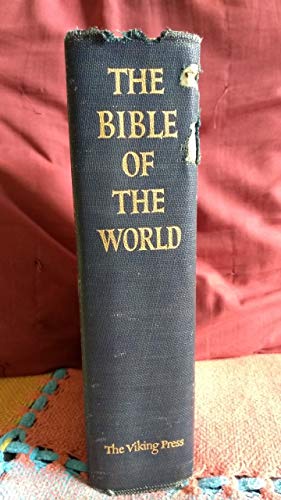
Links to boxes below:
 From Medicine Men to Muhammad: A thematic source book of the history of religions.
by
Mircea Eliade
From Medicine Men to Muhammad: A thematic source book of the history of religions.
by
Mircea Eliade
 Bible of the World
by
Robert O. Ballou (Editor)
Bible of the World
by
Robert O. Ballou (Editor)
 Sacred Texts of the World: A Universal Anthology
by
Ninian Smart (Editor); Richard Hecht (Editor)
Sacred Texts of the World: A Universal Anthology
by
Ninian Smart (Editor); Richard Hecht (Editor)
Note: Some of the anthologies below contain more than just sacred works. Please be careful when selecting from these books.
This guide from MIchigan State University provides an overview (with book titles) to different Buddhist traditions & their sacred works. The IRC owns some of these. Others are huge multi-volume works. Please see Connie regarding any that you may want to use.
 Buddhist Scriptures
Buddhist Scriptures
 Basic Writings of Mo Tzu, Hsun Tzu and Han Fei Tzu
Basic Writings of Mo Tzu, Hsun Tzu and Han Fei Tzu
Primary Sources
Secondary Sources
There are many versions of the Christian Bible. Most are shelved in the 220 area of the library. Please see Connie for assistance if needed.
This guide from Michigan State University discusses some of the versions and gives version titles. IMSA does not own all versions. Please see Connie for any version you may be interested in.
 The Catholic Bible : New American Bible including the revised Psalms and the revised New Testament, translated from the original languages with critical use of all the ancient sources
The Catholic Bible : New American Bible including the revised Psalms and the revised New Testament, translated from the original languages with critical use of all the ancient sources
 Holy Bible
Holy Bible
Note: Some of the anthologies below contain more than just sacred works. Please be careful when selecting from these books.
 Wisdom of Laotse (aka Laozi)
by
Lao Tzú; Yutang Lin
Wisdom of Laotse (aka Laozi)
by
Lao Tzú; Yutang Lin
 The Greek magical papyri in translation, including the Demotic spells
by
Hans D. Betz (Editor)
The Greek magical papyri in translation, including the Demotic spells
by
Hans D. Betz (Editor)
Note: Some of the anthologies below contain more than just sacred works. Please be careful when selecting from these books.
This guide from MIchigan State University provides an overview (with book titles) to different Hindu traditions & their sacred works. The IRC owns some of these. Others are huge multi-volume works. Please see Connie regarding any that you may want to use.
The revealed texts constitute the Veda, divided into four sections: the Rig Veda, the Yajur Veda, the Sama Veda, and the Atharva Veda. The Vedas are hymns that are also accompanied in the total Veda by Brahmanas (ritual texts) Aranyakas (“forest” or “wilderness” texts), and Upanishads (philosophical texts). The Upanishads are also called the Vedanta and come at the end of the total Veda. Though less studied than later texts, the Veda is the central scripture of Hinduism.
The remembered texts consist of post-Vedic texts. Among the most important are two epics, the Mahabharata and the Ramayana; the Bhagavad Gita, a text inserted into the Mahabharata that focuses on the god Krishna; and the Dharamasastras; consisting of the manuals concerning dharma and aphorism on dharma.
Note: Some of the anthologies below contain more than just sacred works. Please be careful when selecting from these books.
 Classical Islam : A Sourcebook of Religious Literature
by
Norman Calder (Editor); Jawid Mojaddedi (Editor); Andrew Rippin (Editor)
Classical Islam : A Sourcebook of Religious Literature
by
Norman Calder (Editor); Jawid Mojaddedi (Editor); Andrew Rippin (Editor)
 The Glorious Koran
by
Marmaduke William Pickthall (Editor)
The Glorious Koran
by
Marmaduke William Pickthall (Editor)
 The Meaning of the Glorious Koran
by
Marmaduke Pickthal
The Meaning of the Glorious Koran
by
Marmaduke Pickthal
Note: Some of the anthologies below contain more than just sacred works. Please be careful when selecting from these books.
 Jaina Sutras, part I and II
Jaina Sutras, part I and II
 The Mishnah
by
Jacob Neusner
The Mishnah
by
Jacob Neusner
 Scandinavian Mythology
by
H. R. Davidson
Scandinavian Mythology
by
H. R. Davidson
Note: Some of the anthologies below contain more than just sacred works. Please be careful when selecting from these books.
Note: Some of the anthologies below contain more than just sacred works. Please be careful when selecting from these books.
 Kabitt Swayye Bhai Gurdas Ji
by
Guradāsa, Bhai
Kabitt Swayye Bhai Gurdas Ji
by
Guradāsa, Bhai
Primary Sources
 African Mythology
by
Geoffrey Parrinder
African Mythology
by
Geoffrey Parrinder
Secondary Sources
 African religions & philosophy
by
Mbiti, John S.
African religions & philosophy
by
Mbiti, John S.
 Africa religiosity and Africa development : understanding Africa traditional religion and its effects on Africa development
Africa religiosity and Africa development : understanding Africa traditional religion and its effects on Africa development
 Aquarian Guide to African Mythology
by
Jan Knappert
Aquarian Guide to African Mythology
by
Jan Knappert